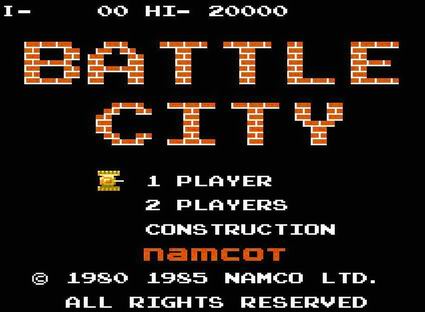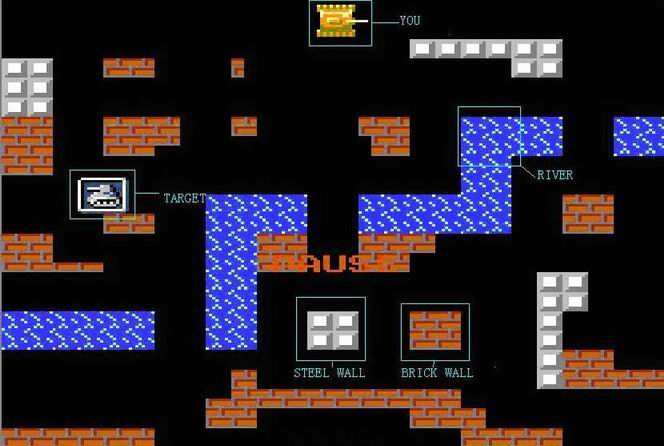poj2312 - Battle City (BFS变形)
2017-03-20 11:03
471 查看
题目链接:点击打开链接
题目:
Battle City
Description
Many of us had played the game "Battle city" in our childhood, and some people (like me) even often play it on computer now.

What we are discussing is a simple edition of this game. Given a map that consists of empty spaces, rivers, steel walls and brick walls only. Your task is to get a bonus as soon as possible suppose that no enemies will disturb you (See the following picture).

Your tank can't move through rivers or walls, but it can destroy brick walls by shooting. A brick wall will be turned into empty spaces when you hit it, however, if your shot hit a steel wall, there will be no damage to the wall. In each of your turns, you
can choose to move to a neighboring (4 directions, not 8) empty space, or shoot in one of the four directions without a move. The shot will go ahead in that direction, until it go out of the map or hit a wall. If the shot hits a brick wall, the wall will disappear
(i.e., in this turn). Well, given the description of a map, the positions of your tank and the target, how many turns will you take at least to arrive there?
Input
The input consists of several test cases. The first line of each test case contains two integers M and N (2 <= M, N <= 300). Each of the following M lines contains N uppercase letters, each of which is one of 'Y' (you), 'T' (target), 'S' (steel wall), 'B' (brick
wall), 'R' (river) and 'E' (empty space). Both 'Y' and 'T' appear only once. A test case of M = N = 0 indicates the end of input, and should not be processed.
Output
For each test case, please output the turns you take at least in a separate line. If you can't arrive at the target, output "-1" instead.
Sample Input
Sample Output
题意:
从Y到T,问最少步数。其中S和R不可走,B要花费两步。
思路:
这里有一个陷阱是,从一个非B的点走到紧邻它的B点花费2步。回到最朴素的bfs实现的思想上,bfs是逐层向下迭代的,所以保证第一次走到终点时的步数是最小的。其中最关键的一点是,从上一层到下一层的路径长度一定是全部相同的。在这题中,从某个点走到下个为B的点花费了两步,这和初始的定义相悖,这将导致走到终点的路径不是最小。很容易举出一个例子来证明这一点。
写法1:
这里我们可以用记忆化搜索,一个vis[i][j]数组表示走到(i,j)这个点时,花费的步数cnt,如果存在某一次到达这个点花费的步数更少我们就把vis[i][j]更新,否则就不这样走。
这样写,必须把所有的可行路径的搜索一遍,效率比较低。
PS:使用这种写法时,在剪枝那一步我写tc>vis[tx][ty]超时了,改成tc>=vis[tx][ty]就AC了,而且还是180ms左右。剪枝还是要能剪就剪!
写法2:
使用优先队列。这道题已经可以看成是求单源最短路了,优先队列可以保证像bfs一样逐层迭代,第一次到达终点时即答案。
写法一:
#include <iostream>
#include <cstring>
#include <cstdio>
#include <queue>
using namespace std;
const int MAXN = 305;
const int INF = 0x3f3f3f3f;
const int dx[4] = {0, 0, -1, 1};
const int dy[4] = {1, -1, 0, 0};
int m, n;
int vis[MAXN][MAXN];
char tu[MAXN][MAXN];
struct Node
{
int x, y, cnt;
Node(int x, int y, int cnt):x(x), y(y), cnt(cnt){}
};
Node st(0, 0, 0), ed(0, 0, 0);
void bfs(){
int ans = INF;
memset(vis, 0x3f, sizeof(vis));
queue<Node> q;
q.push(st);
vis[st.x][st.y] = 0;
while(!q.empty()){
Node tmp = q.front(); q.pop();
if(tmp.x==ed.x && tmp.y==ed.y && ans>tmp.cnt){
ans = tmp.cnt;
continue;
}
for(int i=0; i<4; ++i){
int tx = tmp.x + dx[i];
int ty = tmp.y + dy[i];
int tc = tmp.cnt + 1;
if(tx<0||ty<0||tx>=m||ty>=n) continue;
if(tu[tx][ty]=='S' || tu[tx][ty]=='R') continue;
if(tu[tx][ty]=='B') ++tc;
if(tc>=vis[tx][ty]) continue;
vis[tx][ty] = tc;
q.push(Node(tx, ty, tc));
}
}
if(INF==ans)
printf("%d\n", -1);
else
printf("%d\n", ans);
}
int main(){
while(scanf("%d%d", &m, &n)!=EOF){
if(m==0&&n==0) break;
for(int i=0; i<m; ++i){
getchar();
for(int j=0; j<n; ++j){
scanf("%c", &tu[i][j]);
if(tu[i][j]=='Y'){
st.x = i, st.y = j, st.cnt = 0;
}
if(tu[i][j]=='T'){
ed.x = i, ed.y = j;
}
}
}
bfs();
}
return 0;
}
写法二:
#include <iostream>
#include <cstring>
#include <cstdio>
#include <queue>
using namespace std;
const int MAXN = 305;
const int dx[4] = {0, 0, -1, 1};
const int dy[4] = {1, -1, 0, 0};
int m, n;
bool vis[MAXN][MAXN];
char tu[MAXN][MAXN];
struct Node
{
int x, y, cnt;
bool operator<(const Node &t)const{
return cnt>t.cnt;
}
Node(int x, int y, int cnt):x(x), y(y), cnt(cnt){}
};
Node st(0, 0, 0), ed(0, 0, 0);
int bfs(){
memset(vis, 0, sizeof(vis));
priority_queue<Node> q;
q.push(st);
vis[st.x][st.y] = true;
while(!q.empty()){
Node tmp = q.top(); q.pop();
if(tmp.x==ed.x && tmp.y==ed.y){
return tmp.cnt;
}
for(int i=0; i<4; ++i){
int tx = tmp.x + dx[i];
int ty = tmp.y + dy[i];
int tc = tmp.cnt + 1;
if(tx<0||ty<0||tx>=m||ty>=n || vis[tx][ty]) continue;
if(tu[tx][ty]=='S' || tu[tx][ty]=='R') continue;
if(tu[tx][ty]=='B') ++tc;
q.push(Node(tx, ty, tc));
vis[tx][ty] = true;
}
}
return -1;
}
int main(){
while(scanf("%d%d", &m, &n)!=EOF){
if(m==0&&n==0) break;
for(int i=0; i<m; ++i){
getchar();
for(int j=0; j<n; ++j){
scanf("%c", &tu[i][j]);
if(tu[i][j]=='Y'){
st.x = i, st.y = j, st.cnt = 0;
}
if(tu[i][j]=='T'){
ed.x = i, ed.y = j;
}
}
}
printf("%d\n", bfs());
}
return 0;
}
题目:
Battle City
| Time Limit: 1000MS | Memory Limit: 65536K | |
| Total Submissions: 8639 | Accepted: 2895 |
Many of us had played the game "Battle city" in our childhood, and some people (like me) even often play it on computer now.

What we are discussing is a simple edition of this game. Given a map that consists of empty spaces, rivers, steel walls and brick walls only. Your task is to get a bonus as soon as possible suppose that no enemies will disturb you (See the following picture).

Your tank can't move through rivers or walls, but it can destroy brick walls by shooting. A brick wall will be turned into empty spaces when you hit it, however, if your shot hit a steel wall, there will be no damage to the wall. In each of your turns, you
can choose to move to a neighboring (4 directions, not 8) empty space, or shoot in one of the four directions without a move. The shot will go ahead in that direction, until it go out of the map or hit a wall. If the shot hits a brick wall, the wall will disappear
(i.e., in this turn). Well, given the description of a map, the positions of your tank and the target, how many turns will you take at least to arrive there?
Input
The input consists of several test cases. The first line of each test case contains two integers M and N (2 <= M, N <= 300). Each of the following M lines contains N uppercase letters, each of which is one of 'Y' (you), 'T' (target), 'S' (steel wall), 'B' (brick
wall), 'R' (river) and 'E' (empty space). Both 'Y' and 'T' appear only once. A test case of M = N = 0 indicates the end of input, and should not be processed.
Output
For each test case, please output the turns you take at least in a separate line. If you can't arrive at the target, output "-1" instead.
Sample Input
3 4 YBEB EERE SSTE 0 0
Sample Output
8
题意:
从Y到T,问最少步数。其中S和R不可走,B要花费两步。
思路:
这里有一个陷阱是,从一个非B的点走到紧邻它的B点花费2步。回到最朴素的bfs实现的思想上,bfs是逐层向下迭代的,所以保证第一次走到终点时的步数是最小的。其中最关键的一点是,从上一层到下一层的路径长度一定是全部相同的。在这题中,从某个点走到下个为B的点花费了两步,这和初始的定义相悖,这将导致走到终点的路径不是最小。很容易举出一个例子来证明这一点。
写法1:
这里我们可以用记忆化搜索,一个vis[i][j]数组表示走到(i,j)这个点时,花费的步数cnt,如果存在某一次到达这个点花费的步数更少我们就把vis[i][j]更新,否则就不这样走。
这样写,必须把所有的可行路径的搜索一遍,效率比较低。
PS:使用这种写法时,在剪枝那一步我写tc>vis[tx][ty]超时了,改成tc>=vis[tx][ty]就AC了,而且还是180ms左右。剪枝还是要能剪就剪!
写法2:
使用优先队列。这道题已经可以看成是求单源最短路了,优先队列可以保证像bfs一样逐层迭代,第一次到达终点时即答案。
写法一:
#include <iostream>
#include <cstring>
#include <cstdio>
#include <queue>
using namespace std;
const int MAXN = 305;
const int INF = 0x3f3f3f3f;
const int dx[4] = {0, 0, -1, 1};
const int dy[4] = {1, -1, 0, 0};
int m, n;
int vis[MAXN][MAXN];
char tu[MAXN][MAXN];
struct Node
{
int x, y, cnt;
Node(int x, int y, int cnt):x(x), y(y), cnt(cnt){}
};
Node st(0, 0, 0), ed(0, 0, 0);
void bfs(){
int ans = INF;
memset(vis, 0x3f, sizeof(vis));
queue<Node> q;
q.push(st);
vis[st.x][st.y] = 0;
while(!q.empty()){
Node tmp = q.front(); q.pop();
if(tmp.x==ed.x && tmp.y==ed.y && ans>tmp.cnt){
ans = tmp.cnt;
continue;
}
for(int i=0; i<4; ++i){
int tx = tmp.x + dx[i];
int ty = tmp.y + dy[i];
int tc = tmp.cnt + 1;
if(tx<0||ty<0||tx>=m||ty>=n) continue;
if(tu[tx][ty]=='S' || tu[tx][ty]=='R') continue;
if(tu[tx][ty]=='B') ++tc;
if(tc>=vis[tx][ty]) continue;
vis[tx][ty] = tc;
q.push(Node(tx, ty, tc));
}
}
if(INF==ans)
printf("%d\n", -1);
else
printf("%d\n", ans);
}
int main(){
while(scanf("%d%d", &m, &n)!=EOF){
if(m==0&&n==0) break;
for(int i=0; i<m; ++i){
getchar();
for(int j=0; j<n; ++j){
scanf("%c", &tu[i][j]);
if(tu[i][j]=='Y'){
st.x = i, st.y = j, st.cnt = 0;
}
if(tu[i][j]=='T'){
ed.x = i, ed.y = j;
}
}
}
bfs();
}
return 0;
}
写法二:
#include <iostream>
#include <cstring>
#include <cstdio>
#include <queue>
using namespace std;
const int MAXN = 305;
const int dx[4] = {0, 0, -1, 1};
const int dy[4] = {1, -1, 0, 0};
int m, n;
bool vis[MAXN][MAXN];
char tu[MAXN][MAXN];
struct Node
{
int x, y, cnt;
bool operator<(const Node &t)const{
return cnt>t.cnt;
}
Node(int x, int y, int cnt):x(x), y(y), cnt(cnt){}
};
Node st(0, 0, 0), ed(0, 0, 0);
int bfs(){
memset(vis, 0, sizeof(vis));
priority_queue<Node> q;
q.push(st);
vis[st.x][st.y] = true;
while(!q.empty()){
Node tmp = q.top(); q.pop();
if(tmp.x==ed.x && tmp.y==ed.y){
return tmp.cnt;
}
for(int i=0; i<4; ++i){
int tx = tmp.x + dx[i];
int ty = tmp.y + dy[i];
int tc = tmp.cnt + 1;
if(tx<0||ty<0||tx>=m||ty>=n || vis[tx][ty]) continue;
if(tu[tx][ty]=='S' || tu[tx][ty]=='R') continue;
if(tu[tx][ty]=='B') ++tc;
q.push(Node(tx, ty, tc));
vis[tx][ty] = true;
}
}
return -1;
}
int main(){
while(scanf("%d%d", &m, &n)!=EOF){
if(m==0&&n==0) break;
for(int i=0; i<m; ++i){
getchar();
for(int j=0; j<n; ++j){
scanf("%c", &tu[i][j]);
if(tu[i][j]=='Y'){
st.x = i, st.y = j, st.cnt = 0;
}
if(tu[i][j]=='T'){
ed.x = i, ed.y = j;
}
}
}
printf("%d\n", bfs());
}
return 0;
}
相关文章推荐
- [算法] BFS : poj 2312 Battle City 示例
- poj 2312 Battle City【bfs+优先队列】
- POJ 2312 Battle City 优先队列+BFS
- [算法] BFS : poj 2312 Battle City 示例
- POJ 2312 Battle City(bfs)
- POJ 题目2312 Battle City(BFS)
- poj 2312 Battle City(bfs+优先级队列)
- POJ 2312Battle City(BFS-priority_queue 或者是建图spfa)
- poj 2312 Battle City 优先队列+bfs 或 记忆化广搜
- poj 2312 Battle City(优先队列+bfs)
- Poj(2312),坦克大战,BFS的变形
- POJ_2312_BFS:priority_queue -- Battle City
- POJ 2312:Battle City【BFS & 优先队列】
- 【BFS+优先队列】Battle City(poj-2312)
- poj 2312 Battle City(优先队列+bfs)
- POJ2312 Battle City(优先队列+广搜BFS)
- POJ_2312_BFS:priority_queue -- Battle City
- POJ 2312 Battle City(优先队列+BFS)
- POJ 2312 Battle City (BFS状态搜索)
- poj 2312 Battle City-bfs
